OFF-TOPIC (55)
By:
December 5, 2023
Off-Topic brings you over-the-transom, on-tangent essays, dialogues and subjective scholarship on an occasional, impulsive basis. This time, a between-fans sharing of true-life tales about one of the American Century’s most successful self-made-up men…
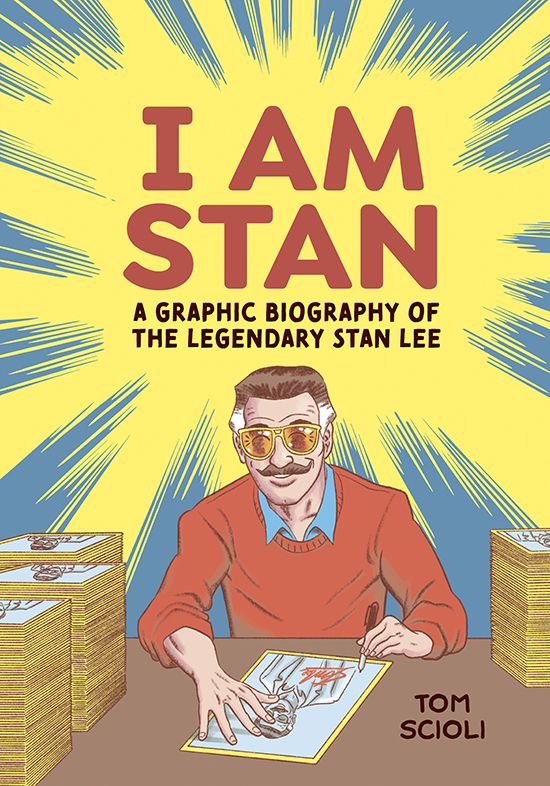
Stan Lee’s life was the kind of book that only opens when it’s finished. Elusive in the spotlight, printer of his own legend, he didn’t create most of what he was credited for, yet it, and he, made a hell of a story. Tom Scioli’s I Am Stan is a great American graphic novel about a quintessential 20th century adherent of the social establishment and architect of new possibilities, a cultural climber and survivor who seized opportunities from others and saw futures we all now live abundantly in. Scioli’s Stan, reconstructed through a phenomenal collage of verifiable incidents and documented statements, self-reveals the most surprising life-storyline and stranger-than-fact psyche, from his charmed and undeterrable childhood, to the gray-flannel gothic of his climb up the corporate cliff-face, to the prime in which he transformed himself at will while orchestrating the evolution of American comics, and the long valediction in which he was revered as a legend and eventually treated as less than a person. Scioli’s essentialist yet fluidly expressive visual shorthand, his vast stylistic arsenal, his ability to stretch and snap time in the profundity and punctuation of his storytelling, shows us Stan as the voiceover of a generation and canvas for the near-century of creative ferment he lived through. Scioli’s economical artistry and emotional instincts observe a definitive showman and strike to the heart of some fundamental truths. Almost exactly five years after Stan’s last day, Scioli and I spoke by zoom about this essential next (not final) chapter…
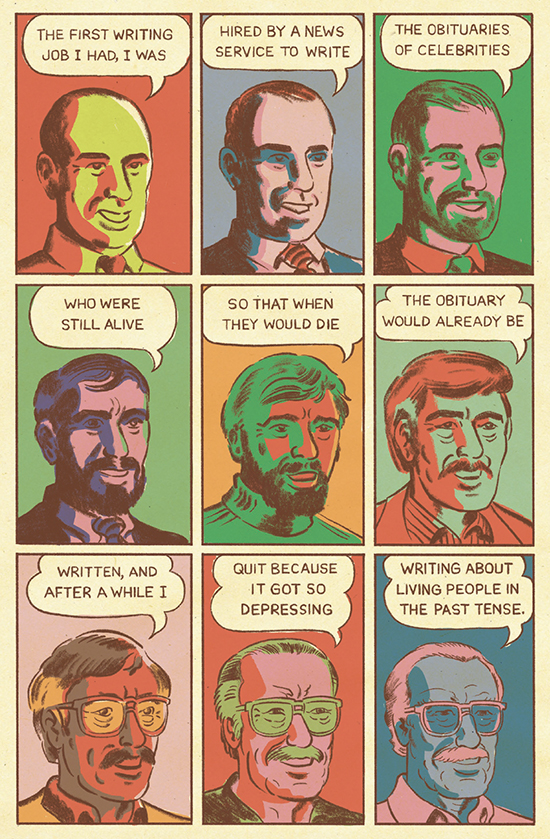
HILOBROW: Towards the beginning of the book there’s this remarkable sequence of psychedelic-colored headshots of Stan which could easily be taking up a wall at the Warhol Museum — which was not really a world that Stan was part of, but was a cultural context of his times, which he did really become one thread of the fabric of. It’s almost saying visually that he was the ultimate cultural chameleon who could make his way through any social situation.
SCIOLI: You’re saying he wasn’t part of that moment, but he was the guy who changed it to “Marvel Pop Art Productions” for a little while [laughter], so he did throw his hat into the ring, he did make his attempt to be part of that cultural moment. Studying Stan Lee and all the different interviews and things, it seems like all his interviews were rough drafts that he was polishing for the story of his life; he’d tell the same anecdotes again and again, but — I’m lookin’ at stuff from the ’60s, I’m lookin’ at stuff from the ’80s, I’m lookin’ at stuff from the 2000s, and you’d see these well-worn anecdotes, and they’re getting more and more refined. So I wanted to touch on some of that. Also [at the start of the book], there’s the one anecdote where he’s talking about working at the news service and writing obituaries and how depressing that is, and that’s exactly what I’m doing, I’m writing more or less an extended obituary, so the irony of that was interesting. And then the Warhol thing just felt right.
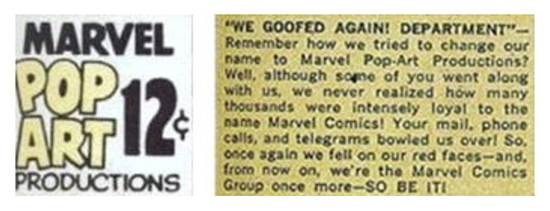
HILOBROW: I did have “Marvel Pop Art Productions” heavily in mind! Do you know why they dropped that so quickly?
SCIOLI: I’d always heard that he was embarrassed by it, that he [thought he] was like, trying too hard to be hip and part of a moment — but I didn’t find any smoking gun, any kind of a memo or anything. I like the “Marvel Pop Art Productions” thing myself, I think they should maybe start that back up again.
HILOBROW: In retrospect it seems perfect; it’s funny how, at a remove of a half-century or more, we see how much he was indeed part of those times and part of that world.
SCIOLI: He was geographically part of it for sure. I think “Marvel Pop Art Productions” would be a much better name for the company than “Marvel Entertainment” or, y’know, “Disney.”
HILOBROW: I wonder if it was a case of a prophet not being without honor save in his own country, since you depict both Italian and French avant-garde filmmakers flocking to the Marvel office.
SCIOLI: They were all descending, yeah. It’s always been interesting to me how much the Marvel comics were embraced by the counterculture and by sort of forward-thinkers, but the people who were making them weren’t really that at all, they were just kind of… I think Stan Lee, Jack Kirby, and Steve Ditko, just from a lifetime in comics, became sort of conditioned to absorb the zeitgeist, put it through their filter and then put it back out, so sometimes it just clicks, and that was a moment where it really clicked.
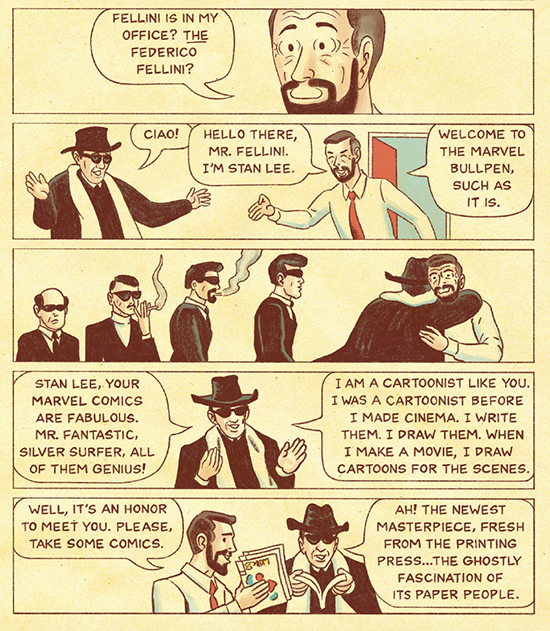
HILOBROW: It’s interesting you mention how [these creators] would click with the zeitgeist, because one thing that occurred to me while reading this, and probably inevitably comparing it to its “bookend,” your Kirby biography, was that… the Kirby book struck me as a single life story, whereas the Stan Lee book strikes me almost as the portrait of an entire era, and I wonder if the difference is ’cuz Kirby was such an originator that you can only understand him in terms of what he brought forth into the culture, whereas Stan is best understood in terms of how he kind of reflected what was going on around him?
SCIOLI: You touched on it earlier, but Stan was more of a chameleon, and Stan just — he had a longer life, and he sort of reinvented himself a few times, where Kirby lived on the page, and it was all about the work. He was never trying to cultivate any kind of identity for himself. He was pretty genuine in that regard, whereas Stan, he just moved in and out of so many worlds, and just by nature of living a lot longer than Kirby, and being a bit better connected, at least in the business aspect of things, he got to be part of that digital age that Kirby didn’t really live to see or be a part of. So, the post-2000 years are… it’s almost like double, like each year is two years or something. Just with the way culture and information changes.
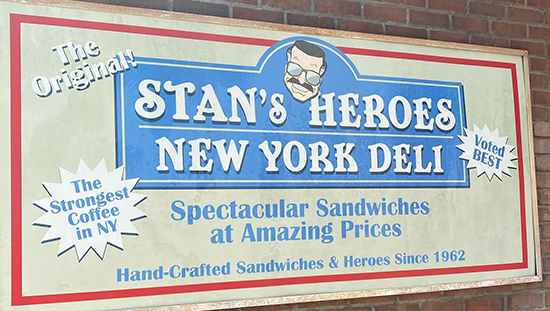
HILOBROW: It’s funny when you talk about how the internet era multiplied the time Stan had on earth and in the zeitgeist, since one thing that struck me as ironic is that now Stan Lee literally has ascended to a cartoon, like whenever you go to certain food stands in Disney parks there’s this mascot, cartoon version of Stan Lee, almost as if he’s been fed into the computer and converted to this cartoon avatar. So I wondered how that might relate to what your shorthand was for depicting him.
SCIOLI: It’s an afterlife, that kind of existence is an afterlife. It’s kind of a hell maybe too! It’s a little bit nightmarish in some of the implications. But that is the risk you run when you “cartoon” yourself; I think [for] a lot of people who make creative works, making yourself “immortal” in one form or another is a goal, and I think it was for sure for Stan. Making a book about Stan was in some ways so easy, because again, he already kind of processed himself into being cartoon-ready, being media-ready. Where with Kirby it was like, “How do I cartoon Kirby, how do I make Kirby into somebody who can be visually understood.” So I made the choices that I made and came up with a stylized Kirby visually, but with Stan, it was already done, and that version of Stan was already preprocessed, preapproved, and accepted by the public. And, sort-of deconstructing Stan, I’ve been spending a lot of time in recent years thinking about Groucho [Marx]. I feel like Stan was maybe bouncing off Groucho a little bit. And Groucho, he did become a cartoon character, but then, kind of reinvented himself in the ’50s as a more… still a character, but a more realistic and genuine character, and less of an arch cartoon the way his initial image was.
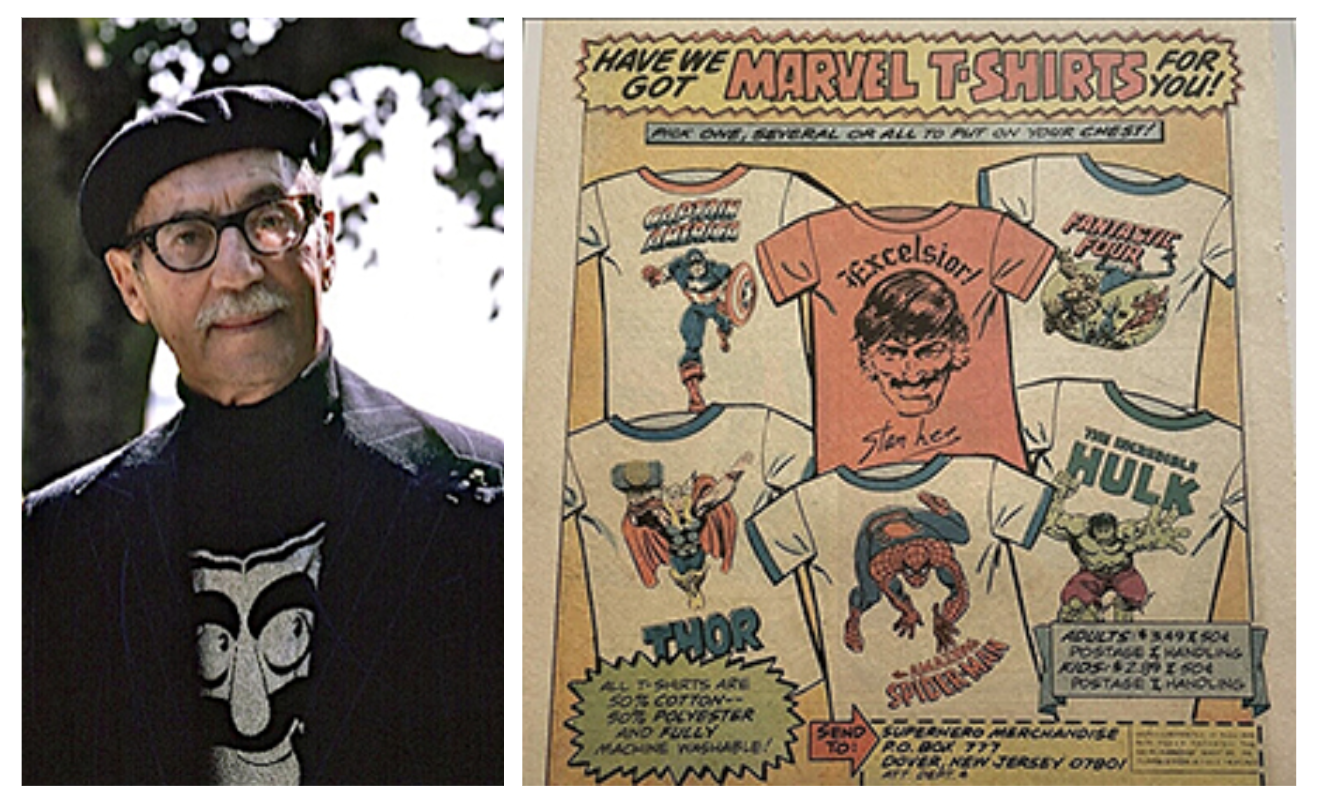
HILOBROW: That’s a great analogy, and interestingly enough I’ve been simultaneously reading a memoir called Raised Eyebrows about this guy who lived in Groucho’s house as his assistant for like the last 5 years of his life. You’re right, he did go through a similar arc, it’s almost like in Groucho’s case he went from “cartoon” to “humorist,” from Mickey Mouse to S. J. Perelman, but it’s the same arc…
SCIOLI: Groucho and Stan both had intellectual ambitions, and both of them wanted to be taken seriously as intellectuals, and never quite got there? Because the forms that they were known for — y’know, both “comics,” two different definitions of the word “comic” — they tried to shed that and push back against that in pursuit of… y’know, Stan did have his “Professor Stan” era.
HILOBROW: Absolutely, going from campus to campus. As we were talking about the respect he got from filmmakers, it just occurred to me that the scene with Alain Resnais, it’s almost like Resnais as you portray him stands in for all the people in the audience who unquestioningly worshipped Stan (which could be many of us reading the book). Because the way that Stan says “I hope I’m not a disappointment” and Resnais says “Ah, the Stan Lee self-deprecating wit. You are exactly as I pictured you,” it’s like there’s nothing Stan could do to disappoint him.
SCIOLI: His persona, and even before the persona, the voice that he was starting to develop, which initially was just the “Marvel voice” in the comics, and then eventually becomes Stan’s voice, but that kind of self-deprecation, it’s like a no-lose situation. If he’d sort of brag, and say “This is the greatest thing ever,” he’s saying it with a wink, so, if you thought “Well this is ridiculous, this couldn’t be the best thing ever, and why are you patting yourself on the back,” it’s like, well, “C’mon, we’re joking,” but if you took it seriously, “Yeah, he really is the greatest,” and this issue of, Fantastic Four or whatever, is the greatest thing of all time, then he wins there too. It branches off in two directions, and both of them are a win.
HILOBROW: Which seems to be something it was very important for Stan to engineer. He very subtly and maybe not even consciously seems to have tried to arrange all the chess pieces so that he would come out favorably. I wonder if there’s a… third side to the coin in terms of that self-deprecation, in that… do you have the impression that Fellini and Resnais’ worship was completely authentic, or did they in some ways ironically think of Stan in the way that the New York Herald Tribune reporter thought of Jack, I mean, look down on him a bit, think of him as a kind of pet?
SCIOLI: That’s interesting, but no, I think they really, I think they did see him as some kind of guru, and genius; and again, it is that kind of uncritical worship — and maybe you had this with Stan when you were younger, and I certainly had it when I was younger — of, you just sort of credit him with the whole kit and caboodle. So if you’re looking at an issue of Thor, one of those really great issues, or the Galactus Saga or whatever, and in your mind — even if maybe you are conscious of the idea of there being inkers, and a Jack Kirby, and a guy who’s doing the masthead, Artie Simek or somebody — even if you are fully aware of that stuff consciously, if you are emotionally assigning authorship to one guy and it’s Stan Lee, then he really must be a supergenius‚ you must bow down before this guy who is “creating” this. When in fact it’s two people, plus a couple more people also, and you’re sort of pushing them all together. So I think that they [had that]. And in the case of Fellini, coming from an art background, a cartooning background, even more so. (And in Europe, they did have a degree of respect for comics as an artfom.)
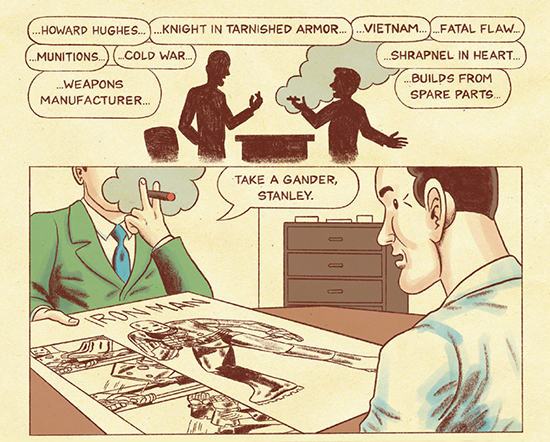
HILOBROW: You were talking before about how it was, perhaps strangely, more of a challenge to do a graphic biography of Kirby, who was known primarily for his visuals, than it was for Stan; on the other hand I’m sure there’s monumental challenges presented by having to visualize writing, as for the subject of this book. And I feel you achieved some really unprecedented and inventive syntheses in order to do that. In some cases you almost enlist words to do the work of imagery; one thing that really stands out to me is, there’s the unknowable process of how, of who did what and who came up with what when Kirby and Lee were collaborating; so the solution you came up with, of these stalkless word balloons, almost like fronts of clouds that are gonna come together and rain the finished project into their minds, was really brilliant. And even in other cases, where you use words almost like neither language nor image but almost like just this glyph that signals our minds on how to read the emotion of a scene, like all the “NO”s from Joan [Lee] when they lose their second child.
SCIOLI: I think that’s one of the benefits of hand-lettering your comic, because then the words are artwork, it is a drawing. Another thing I leaned into that really helped was just that, the typewriter has become so romanticized, it’s just sort of this beloved old technology, and so mysterious and arcane, so you can lean into that. If you’re making a thing in the ’70s and had a typewriter it would almost be invisible, where here it’s like, “Ooh, he’s getting’ ready to start TYPING, this is exciting!” [laughs]
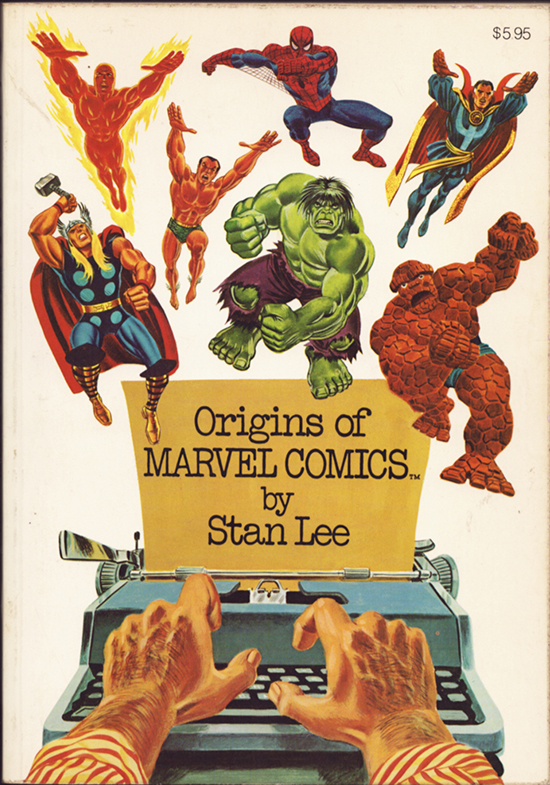
HILOBROW: The image of his fingers at the typewriter is a recurrent motif in this book, and I wondered if your startoff reference for that was the cover of the original Origins of Marvel Comics?
SCIOLI: For sure, that’s part of the iconography of Stan’s life. The irony is, in that Origins of Marvel Comics, the hands that are going in there, they’re in the position of more of a traditional piano player, that sort of traditional typing system, when the Stan Lee thing would really be like two pointed fingers, because he was basically hackin’ it out with just two fingers. From what I understand that was his style of typing.
HILOBROW: That perfectly intersects with the James Montgomery Flagg, “I Want You” image, which you do devote one whole-page panel to [laughs].
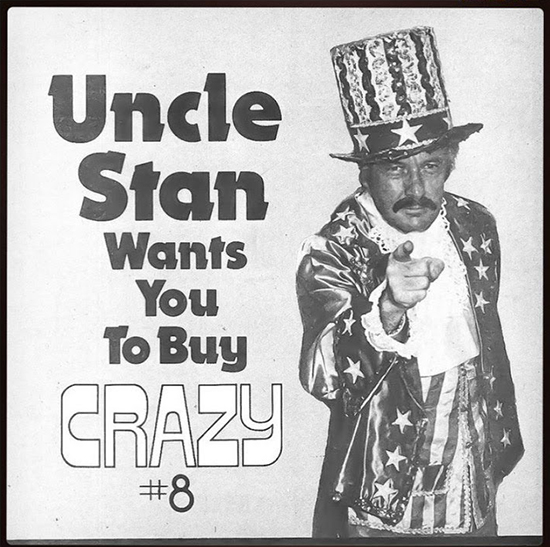
SCIOLI: I had to put that in there at some point! I’m thinking about the Stan Lee I knew as a kid, and there was the Saturday morning cartoons, where he was like the voiceover, and then the ones in the ’90s, but also when I was a kid there was a lot of Crazy Magazine laying around, and I feel like Stan was a presence in those; that might’ve been where I first saw that Stan Lee-with-Uncle-Sam-hat kinda thing.
HILOBROW: I had also thought of the piano analogy, when you show Stan sitting down to type his first-ever story for Marvel and cracking his fingers like he’s about to play a concerto.
SCIOLI: We’ve seen how all kinds of workaday tools can be romanticized — y’know, the turntable. The chainsaw. But the typewriter, it’s so ripe for that stuff, and [for] yes, “making his music” with it.
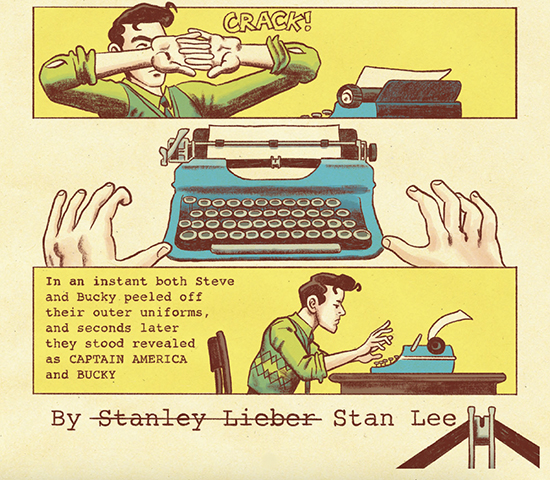
HILOBROW: Talking about Stan being a presence even in Crazy Magazine, one thing I found very significant and perceptive that you spent some time on in this book was Stan’s commitment to his funny-caption magazines…
SCIOLI: Oh yeah, that’s a whole other career almost, sort of a parallel track. And it’s real easy to forget that; history has preserved all the comics things, because comics history is so well documented, and the “experts” are fans and they’re obsessive about every detail. But those… Martin Goodman’s magazines were everywhere, they were incredibly prolific, they were like their own cultural thing. And Stan’s funny-caption kind of stuff — I mean, he claims a lot of credit for sort of inventing that genre. At the very least he certainly helped popularize it, in terms of how much ground you can cover, with those prolific Martin Goodman printing presses.
HILOBROW: I would go even farther in giving him credit, ’cuz as I was reading those parts I realized that Stan deserves at least partial credit as the father of the meme. A connection I don’t think anyone has made*, but he was seeing forward to that. You even have him saying “It’s a formula that works — putting funny captions on photos.” [*I thought wrong; at least one had, Jillian Steinhauer in The New Republic, by 2021.]
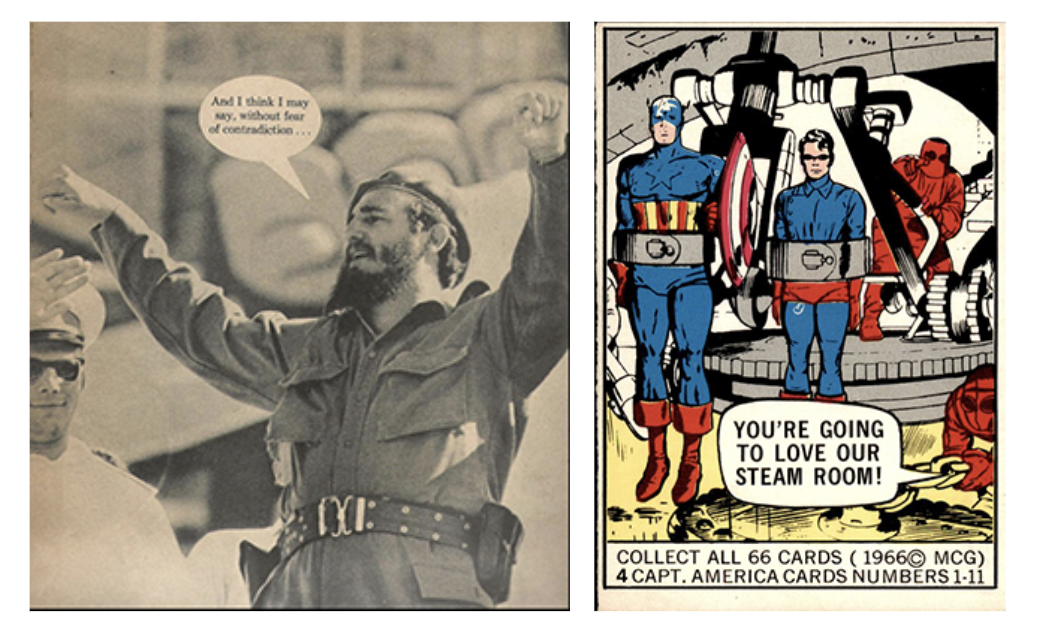
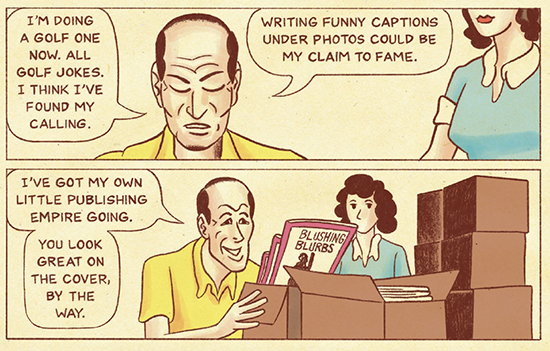
SCIOLI: He had all those things that are the ingredients to success, because he had access, and he was in there early. He kept bumping up against the limitations of being a comics editor as opposed to being in one of the more respected parts of the Goodman empire or just publishing in general. But he had so much autonomy, and it’s really such a privileged position to be, like, in your teens, and then barely out of your teens, and be the sole editor overseeing this line of product, and a line of product where it’s so looked down on that the interference was pretty minimal. Goodman definitely had his things he wanted, but there was just so much leeway. There aren’t too many other people you could look at, especially in comics, and say “That guy is kinda like Stan.” The other editors at other companies, it wasn’t a one-man show the way it was for Stan. And he did have his excesses; he did push things too far in that postwar era, he went a little bit nuts I think. Even with the sort-of cherry assignment he had in the army, especially as compared to Jack Kirby or someone, it was still a regimented way of living which I’m sure was not something he was a big fan of. So when his military service was over, he had a lot of steam to blow off.
HILOBROW: I loved your notes in the back, for tracing the provenance of certain of these incidents; but what is the source of that anecdote where he climbs onto the top of a filing cabinet and has people line up past him giving homage to their “king”?
SCIOLI: That was Adele Kurtzman. She did this pretty famous interview — because she was Stan’s secretary in those days — so she knew all the, she had all the dirty secrets. And I think there was somebody else who confirmed that story, I think maybe even Wally Wood. But Adelle Kurtzman had, she was the one who sort-of exposed that era of Stan and how terrible it was. And the thing of Stan whipping everybody was corroborated by others as well.
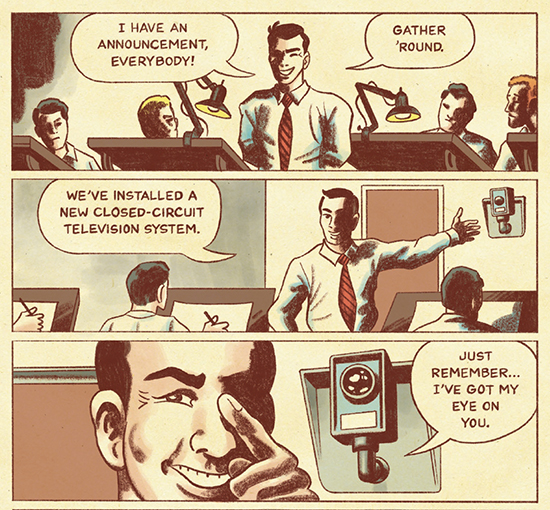
HILOBROW: It’s funny, it’s as if no matter how old he got he was still the annoying kid playing the ocarina in your ear.
SCIOLI: Yeah, except he had some power, he was kind of feeling himself, he was a little more sure of himself in that period. But I think he worked through it, he grew up a bit, and from that point onward he was passive-aggressive as opposed to just out of control.
HILOBROW: Wow, that’s an interesting way of putting it, because he channels it in different ways, and one thing I felt was very striking, and sad, about this book was the way you depict this almost, as-old as-human-history pecking order of people exploiting or being able to exert power over each other… time and again we’ll see phrasing that Martin Goodman will use to belittle and demean Stan then used by Stan with some subordinate of his, like “Don’t be dramatic”… and nobody escapes unimplicated in this, the loop of people getting away with what they can with whomever they have power over stretches in both directions. Joe & Jack take Stan into their confidence about moonlighting for National/DC and he immediately betrays them, but before that, they had been using their position to just ignore and disdain him whenever they could, and then once they’re fired, Stan steps up to be editor and Goodman immediately passes over him. The chain just continues.
SCIOLI: These are human stories; you put a bunch of human beings together in a high-stakes, competitive situation, like the Wild West that newsstand publishing was back then, and even in the architectural and geographical confines of working in those times when there actually was a “bullpen” [at the Marvel offices], and in the confines of Manhattan itself, you’re gonna have a lot of people butting heads. Even somebody like Martin Goodman, who was sort of at the top, he didn’t have a boss that he answered to, I didn’t get into this too much, but when it came time to selling the company he found himself hitting into barriers that he could not have anticipated, having been so autonomous for all those decades.
HILOBROW: And even at his zenith he was subject to certain pecking orders, like the way that he can both influence but also has his strings pulled by the Comics Code, by DC’s distributor [which Marvel for a time was obligated to use]…
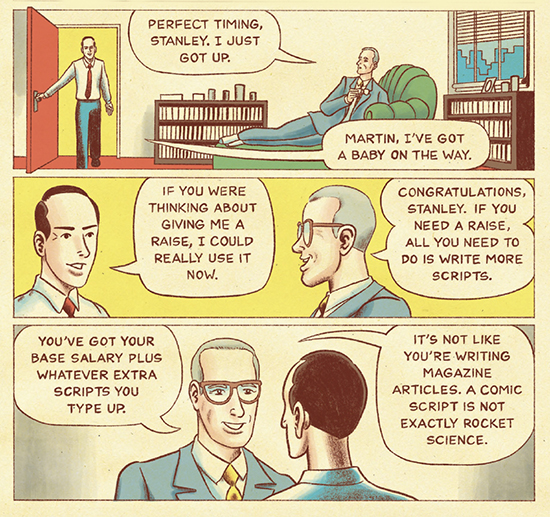
SCIOLI: Also, and you see this for Stan, there’s something about the social world, when you’re at a party, and you’re trying to be upwardly mobile like Stan was… I’m sure Goodman [too] had uncomfortable moments at cocktail parties, [with] his peers, who might have been in more “reputable” businesses than comics and the sort of “trash” publishing he was doing.
HILOBROW: Did Goodman actually publish anything that couldn’t be seen by someone as trash? Because basically he had the comics division, the dirty magazines division [laughs]…
SCIOLI: Yeah. I mean, he had, I’ve found some… you see modern equivalents of this now, where it would be like, “Celebrating the Heroes of WWII,” these kind of things that seemed almost without an identity, no author attached to them; and Martin, with his revolving door of publishing business names, it’s just this thing that appears on the shelves and looks respectable but you have no idea how it got here on the newsstand.
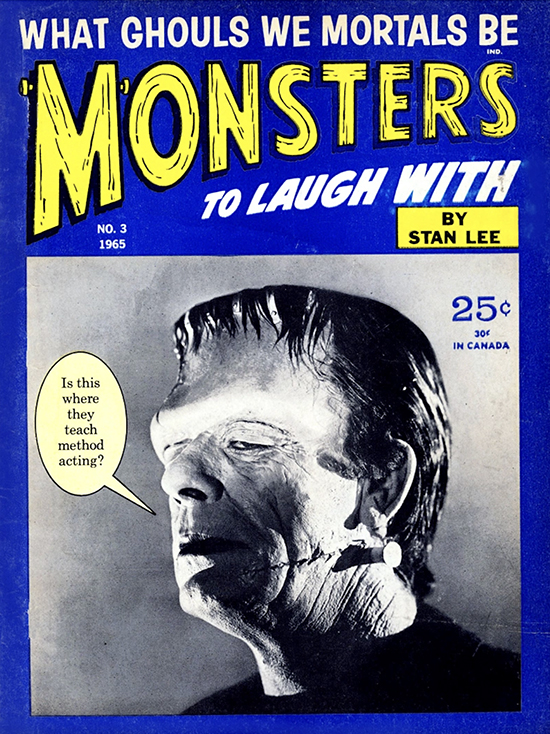
HILOBROW: Within this Darwinian hierarchy, it’s fascinating to focus in on Stan himself and to contemplate what was going on inside his head — the Kirby book was all in first-person, an oral-history format, whereas the Stan book is all composed, very masterfully, of things we know from outside of these guys’ heads. The first book was Kirby (and sometimes Stan and others) telling their own story first-person; this is all the stuff that we can get from the public record, or what people have said he said. Does this give you a feeling that Stan’s the kind of personality we can only ever hope to piece together from certain evidence?
SCIOLI: Right, because he did live so much on the surface, and was so focused on the surface. And it seemed like even in his personal relationships, there was a level of artifice. And again, we don’t know what it’s like when the camera’s off, but just the glimpses you see of his relationship with Joan — and again, I avoided, I’m not a doctor or anything like that, so I avoided diagnoses or anything like that — but there’s just somethin’ weird about their interactions, and the one-upmanship; it’s like “do you guys ever turn this off?” But yes, ultimately the real Stan is maybe unknowable — and I mean, the same’s true of Jack Kirby; you only know what people allow you to see. But Stan had sort of a guarded sense, where Kirby just seemed to wear his heart on his sleeve a lot, there was just so much that seemed to come from the heart. I feel like we — again, there’s fewer interviews, less footage of Kirby, but I feel like we’re able to learn so much from that much smaller body of evidence than the Stan stuff, where after a certain point it’s just all sheen.
HILOBROW: Do you have even a conjectural impression of what kind of pain Stan might have been processing… probably throughout his life, since it really strikes me, time and again, we see tragedy striking. He kind of comes from a form of tragedy, in that his parents hate each other and that’s all he’s exposed to; then time and again we see him keeping a brave face through the death of their second child, the anti-Semitism that prevents them from adopting another child, and even later on, Joan dying. It’s like he’s always relentlessly positive, and sometimes it’s at the same time beautiful, and sad and frightening, like the first time he meets Joan [the woman of his dreams and, strangely, of an idle cartoon he has often doodled] and he’s like, “Meet your creator” — on the one hand it’s like, “Wow, this sounds like a controlling lunatic,” but on the other hand it’s like, no, this is a person who thinks that they can will their dreams into reality and everyone will play along. And I assume that must be the surface quality of someone who’s kinda desperate to make things right, and I’m wondering if you have any thoughts on… what he was trying to make right.
SCIOLI: And then there’s just the generational trauma of the Great Depression and things. So I can see how somebody would live through the 20th Century and come out at some point with your guard up at all times. … And be sort of a people-pleaser, and try not to get anybody angry. There are moments for Stan, there was the late interview he did with Larry King, maybe his last, where they started getting kind of metaphysical, and King asks him do you believe in an afterlife, and Stan’s like, I don’t believe in an afterlife, he’s a very sober, unusually sober and unguarded Stan, not mincing words; that was one of the interviews that stood out to me, as, “There’s definitely something here, this is not just more of the same.”
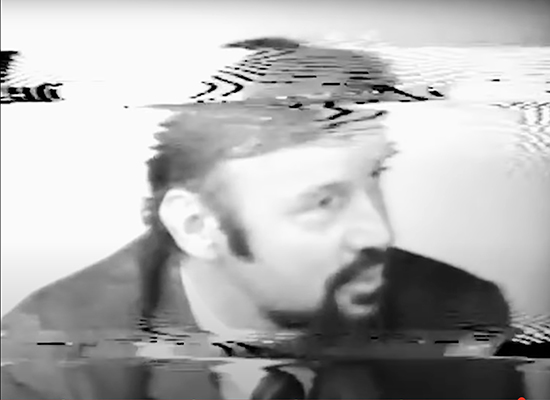
HILOBROW: That was a striking incident, and the way you accentuate it just now makes me see in a different light Stan’s… conservatism I guess is a way of putting it, clearly he was politically more middle-of-the-road than Kirby and a lot of these guys — and indeed you depict that very honestly, as in that clip from his [1968] talkshow [pilot], where he’s—
SCIOLI: So great. I love that. That talkshow, that Stan Lee talkshow was really wonderful. And it was like — it’s the rude awakening, and maybe you and I will experience this too, where you think of yourself as in-the-know, and hip, and yeah, you’re definitely more forward-thinking than all the other people that are around your age and in similar circumstances that you hang around with, but start hanging around with the new generation or whatever, and Stan… among comic book editors, Stan was probably pretty on top of things, but then when he’s talking to a real, genuine intellectual who’s questioning authority, it was like he was talking to somebody from another planet, he was completely turned around. And he wasn’t gonna allow himself to be caught in that position, ever again.
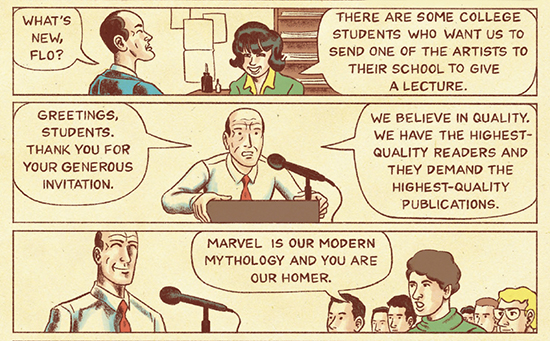
HILOBROW: You put yet another spin on it, about generational perspective, even way above “politics,” and what you were making me contemplate a moment ago was that, given that he had emotions to hold in and, like you said, “surviving the 20th century,” it could be that his apparent affinity for the status quo might have been mostly about him wanting there to be a reliable system, because if there isn’t, then not only might the world as he knows it go to pieces, but he would go to pieces.
SCIOLI: He seemed to really be invested in hierarchy. And I think he was in some ways so obsequious to Martin — even though he would push back against him — I think he really did at his core believe in a hierarchy, and I agree that can be comforting. The idea that the universe is very wonderfully ordered, and everything is in its place, and there’s a Martin Goodman, and there’s a Stan Lee [laughter] and there’s the lowly freelancers.
HILOBROW: I’d rather believe that there’s no afterlife before I’d accept that there is a Martin Goodman [laughter]. Particularly as I got into the later stages of the Stan book, where it becomes almost kaleidoscopic in terms of the incidents of his life, I was reminded how Mark Evanier has pointed out that in Kirby’s mature work you hardly ever see a scene that ends in the middle of a page, because he wanted to be able to, and sometimes did, juggle the sequence of scenes. Was that a consideration you had with this book, and if so, did you conceive of any of these incidents having a different sequence than they ended up with?
SCIOLI: For sure, that was part of the process from the very beginning and there was some filmic editing, juggling and moving the parts around. My initial conception of the book was a much more unstuck-in-time, nonlinear narrative. But then when it came time to make it, it settled into a much more linear… it’s largely linear, but there are certain moments when things are sort of grouped together for clarity’s sake, where they kind of play off each other better than if you were to assemble them in a strictly chronological order. But there was a lot of moving pieces around. I wouldn’t deliberately limit myself if I felt a sequence could have a little more breathing room, and there are some sequences that do follow a more traditional page-to-page thing. But I was trying to make each page into a statement, so that it wasn’t just like you’re watching a movie and you suddenly have to put in a new reel because your film ran out. But to try and have them begin and end in a way that they are a unit.
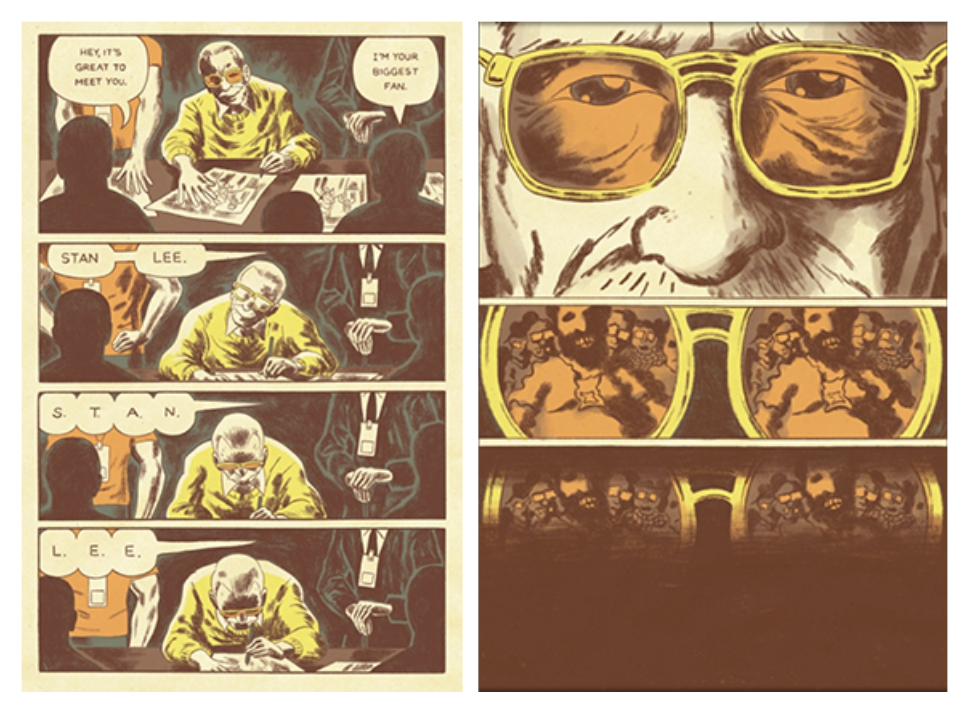
HILOBROW: There are scenes in the book where I as a reader would like to have known more, but I completely appreciated and respected how you left it open-ended, like — what is that scene where Joan smashes Stan’s typewriter?! — I don’t know if that was partially that you wanted to stick to what is part of the public record, or at least people’s recollections, and leave him some privacy or not inject your own conjecture into it, or… what went into your telescoping in on those moments?
SCIOLI: Yeah, because in that specific instance we don’t know; Stan’s told that story a couple times, and I think there have been interviews where Joan talked about it too; and sometimes Stan will assign some sort of innocuous, “Oh it was because I said why don’t you wear a different color dress” [as the catalyst], but we never got an answer about what this argument was. I have some guesses, but I can’t support them with anything so I’m not gonna put that in there … and again, the comic form is a staccato form, it is not a continuous flow. You can do things to smooth out the flow — and Stan was a believer in doing things to smooth out the flow — but the inherent nature of the form is staccato. And that’s very liberating, because with something like film, you’re trying to maintain this illusion of continuity and this uninterrupted moment. And when you do break that, you break the spell. But with comics that’s not the case, because you’re constantly breaking the moment, it’s just the nature of it. So you can drop in a bomb like that, like, “Wow, she’s throwin’ this thing on the ground,” and it doesn’t take you out of it the way that in a film, it would be kind of like, “How did we get here?!”
HILOBROW: It’s interesting that you say you don’t want to conjecture, and yet one of the things I find really remarkable about this book is that, whereas the Kirby book — and any number of others by other authors — is the account of a life, this one is the interpretation of a life. And what’s remarkable about that, in turn, is that you have taken a nothing-but-the-facts approach; it doesn’t overstep its bounds but it is very clearly an interpretation rather than saying this is the definitive story of his life. What was your own… conclusion is a limiting word, but what do you think is the impression that this book gives? To the extent that you can even perceive it, what is the interpretation of Stan in this book?
SCIOLI: It’s too complicated — if I could boil it down to a sentence, I would’ve made a sentence [laughter]. And Stan is — he’s a complicated guy. Like everybody who walks this earth, he’s a complicated guy; full of contradictions, many facets, and I can see why you could be angry with him, or disappointed; I can also see why you could really be incredibly fond of him. And I’ve had that full range of emotions with him too. Think about the people in your life, think about family and friends, and what warm feelings you can have for them and what profound frustration you can have with them too.
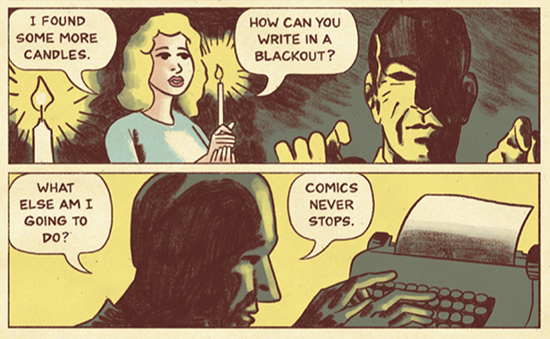
HILOBROW: It almost feels like the first few pages of the book, with a swirl of significant fragments from his late and midlife and one recollection from his youth, are the vision of what it might have been had it been completely collaged, nonlinear as you said.
SCIOLI: The initial pages are sort of of-a-piece, and were created at a time when I had that idea of it being nonlinear. But when you’re making a book, you’ve gotta allow the material to take you where it’s gonna take you. You’re gonna come in with preconceptions of how you think this thing “should” go, but just from my years of experience, you just kind of let the story tell you what it’s about. Those pages you’re talking about are grouped together, they’re sort of pre-credits, then the book proper begins. It starts late in his life, then it becomes more linear, when it’s the story of “Little Stan Lee” we’re telling, then as we approach the time where the bookend would be, as we approach that late in his life, the gaps get larger and it becomes a little more unstuck from time; there’s a definite arc to it and a rhythm to it.
HILOBROW: Did you ever witness an incident like the one we see at the front of the book, where Stan is being coached to even sign his own autograph?
SCIOLI: No, just the footage. When I met Stan, was not that many years before that, it was maybe 5 of 6 years before that — he was lighter than air, I felt old and deflated by comparison. It was at the end of a convention day, so I was completely fried — and then Stan Lee is just, kind of, doing twirls, dancing up the stairs, light on his feet [laughter].
HILOBROW: I thought it was truly beautiful the way the book opens with that pitiful scene of him seemingly being exploited and such a peaceful one at the end.
SCIOLI: It’s all there; Stan — he lived a life, and all the ingredients are there. And his life does tell a story, and there’s a beauty in it.
MORE POSTS by ADAM McGOVERN: OFF-TOPIC (2019–2024 monthly) | textshow (2018 quarterly) | PANEL ZERO (comics-related Q&As, 2018 monthly) | THIS: (2016–2017 weekly) | PEOPLE YOU MEET IN HELL, a 5-part series about characters in McGovern’s and Paolo Leandri’s comic Nightworld | Two IDORU JONES comics by McGovern and Paolo Leandri | BOWIEOLOGY: Celebrating 50 years of Bowie | ODD ABSURDUM: How Felix invented the 21st century self | KOJAK YOUR ENTHUSIASM: FAWLTY TOWERS | KICK YOUR ENTHUSIASM: JACKIE McGEE | NERD YOUR ENTHUSIASM: JOAN SEMMEL | SWERVE YOUR ENTHUSIASM: INTRO and THE LEON SUITES | FIVE-O YOUR ENTHUSIASM: JULIA | FERB YOUR ENTHUSIASM: KIMBA THE WHITE LION | CARBONA YOUR ENTHUSIASM: WASHINGTON BULLETS | KLAATU YOU: SILENT RUNNING | CONVOY YOUR ENTHUSIASM: QUINTET | TUBE YOUR ENTHUSIASM: HIGHWAY PATROL | #SQUADGOALS: KAMANDI’S FAMILY | QUIRK YOUR ENTHUSIASM: LUCKY NUMBER | CROM YOUR ENTHUSIASM: JIREL OF JOIRY | KERN YOUR ENTHUSIASM: Data 70 | HERC YOUR ENTHUSIASM: “Freedom” | KIRK YOUR ENTHUSIASM: Captain Camelot | KIRB YOUR ENTHUSIASM: Full Fathom Five | A 5-part series on Jack Kirby’s Fourth World mythos | Reviews of Annie Nocenti’s comics Katana, Catwoman, Klarion, and Green Arrow | The curated series FANCHILD | To see all of Adam’s posts, including HiLo Hero items on Lilli Carré, Judy Garland, Wally Wood, and others: CLICK HERE
